




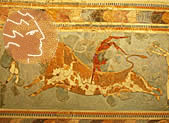
Phaistos
Phaistos is located 62 km south of Heraklion city. Phaistos was one of the most important centres of Minoan civilization, and the most wealthy and powerful city in southern Crete. It was inhabited from the Neolithic period until the foundation and development of the Minoan palaces in the 15th century B.C.
Chronology
4th millenium
3200 - 1400 BC
1400 - 8th century BC
7th - 6th century BC
end of the 4th century - 160 BC
The Minoan city covered a considerable area around the palatial centre. After the destruction of the palace in the 15th century, the city continued to be inhabited in the Mycenaean and Geometric periods, that is, until the 8th century B.C.
Later, the temple of Rhea was built to the south of the old palace. The Hellenistic city was extremely prosperous houses of the period are to be seen in the west court (upper terrace) of the palace. In the middle of the 2nd century B.C. it was destroyed and dominated by the neighbouring city of Gortyn. Traces of habitation dating from the Venetian period are scattered in the whole area. The archaeological investigation of Phaistos started in 1884 by F. Halbherr and continued by the Italian Archaeological School at Athens, under the direction of F. Halbherr and L. Pernier in 1900-1904 and by Doro Levi, in 1950-1971.
The most important monuments of the site are:
- The Palaces (old and new). They are built of ashlar blocks and spread on different terraces. To the central, peristyle court are opened the royal quarters, the storerooms, a lustral basin, and workshops. The monumental propylon and the large staircases faciliate access to the many terraces.
- Minoan and later town. Sections of the town have been located at the sites called Chalara and Aghia Photeini, SE and NE of the palace, respectively.
- Venetian church of St. George of Phalandra. It lies to the west of the palace, on the left of the road that leads to the archaeological site of Aghia Triada and Matala.
The Palace of Phaistos
The Palace of Phaistos with its superb architectural composition and its almost perfect construction, is considered to be the finest and most typical of all Minoan palaces. The ruins of the old and new palace are preserved today, the former having been protected under a shed. The nucleus of the new palace is a central peristyle court around which the rooms are arranged: the storerooms and shrines on the west side, the royal quarters on the north and the workshops on the east. To the west of the storerooms is the "theatral area" with the "processional ways" and, in the lower strata, the granaries of the Old Palace period (first palace). The West Propylon, the monumental entrance to the palace is the most impressive known structure of its kind. The finds from the palace are now exhibited in the Archaeological Museum of Herakleion.
Like at Knossos, the first (old) palace was built at the beginning of the 2nd millenium B.C. (MM I period) and remained in use for about three centuries (2000-1700 B.C.). It was destroyed by fire in ca. 1700 B.C. On its ruins a new palace was erected but was also destroyed in the mid-15th century B.C. (LM IB) along with the other Minoan palatial centres. The palace was abandoned thereafter and only some of its parts were occupied by individuals in the late Post-palatial period. In the Archaic period the temple of the Great Mother or Rhea was built on the remains of the Old Palace period, in the southern part of the palace.
The Phaistos disc
This most famous example of Minoan pictographic script, unique in its kind, was discovered inside a small room of the Phaistos palace. It dates to the early Neopalatial period and is preserved intact. Both sides of the disc have signs impressed in a single spiraling line beginning at the edge and ending in the centre. The inscription uses forty-five different signs, which are repeated and grouped together to form words separated by vertical incisions. The signs were impressed on the unbaked clay using seals and for this reason the disc is considered as the earliest known example of typography. Until now several different interpretations of the text have been suggested, none of which is entirely convincing. Modern scholars believe it to be a religious text or hymn. It is noteworthy that several signs of this inscription appear on an axe from Arkalochori.
Open
Summer:
From the 10th of April until the 31 of October 2009
08.30-20.00
Tickets
Full: €4, Reduced: €2
Special ticket package: Full: €6, Reduced: €3
Valid for: Phaistos, Royal villa at Agia Triada
Phaistos is located 62 km south of Heraklion city. Phaistos was one of the most important centres of Minoan civilization, and the most wealthy and powerful city in southern Crete. It was inhabited from the Neolithic period until the foundation and development of the Minoan palaces in the 15th century B.C.
Chronology
4th millenium
3200 - 1400 BC
1400 - 8th century BC
7th - 6th century BC
end of the 4th century - 160 BC
The Minoan city covered a considerable area around the palatial centre. After the destruction of the palace in the 15th century, the city continued to be inhabited in the Mycenaean and Geometric periods, that is, until the 8th century B.C.
Later, the temple of Rhea was built to the south of the old palace. The Hellenistic city was extremely prosperous houses of the period are to be seen in the west court (upper terrace) of the palace. In the middle of the 2nd century B.C. it was destroyed and dominated by the neighbouring city of Gortyn. Traces of habitation dating from the Venetian period are scattered in the whole area. The archaeological investigation of Phaistos started in 1884 by F. Halbherr and continued by the Italian Archaeological School at Athens, under the direction of F. Halbherr and L. Pernier in 1900-1904 and by Doro Levi, in 1950-1971.
The most important monuments of the site are:
- The Palaces (old and new). They are built of ashlar blocks and spread on different terraces. To the central, peristyle court are opened the royal quarters, the storerooms, a lustral basin, and workshops. The monumental propylon and the large staircases faciliate access to the many terraces.
- Minoan and later town. Sections of the town have been located at the sites called Chalara and Aghia Photeini, SE and NE of the palace, respectively.
- Venetian church of St. George of Phalandra. It lies to the west of the palace, on the left of the road that leads to the archaeological site of Aghia Triada and Matala.
The Palace of Phaistos
The Palace of Phaistos with its superb architectural composition and its almost perfect construction, is considered to be the finest and most typical of all Minoan palaces. The ruins of the old and new palace are preserved today, the former having been protected under a shed. The nucleus of the new palace is a central peristyle court around which the rooms are arranged: the storerooms and shrines on the west side, the royal quarters on the north and the workshops on the east. To the west of the storerooms is the "theatral area" with the "processional ways" and, in the lower strata, the granaries of the Old Palace period (first palace). The West Propylon, the monumental entrance to the palace is the most impressive known structure of its kind. The finds from the palace are now exhibited in the Archaeological Museum of Herakleion.
Like at Knossos, the first (old) palace was built at the beginning of the 2nd millenium B.C. (MM I period) and remained in use for about three centuries (2000-1700 B.C.). It was destroyed by fire in ca. 1700 B.C. On its ruins a new palace was erected but was also destroyed in the mid-15th century B.C. (LM IB) along with the other Minoan palatial centres. The palace was abandoned thereafter and only some of its parts were occupied by individuals in the late Post-palatial period. In the Archaic period the temple of the Great Mother or Rhea was built on the remains of the Old Palace period, in the southern part of the palace.
The Phaistos disc
This most famous example of Minoan pictographic script, unique in its kind, was discovered inside a small room of the Phaistos palace. It dates to the early Neopalatial period and is preserved intact. Both sides of the disc have signs impressed in a single spiraling line beginning at the edge and ending in the centre. The inscription uses forty-five different signs, which are repeated and grouped together to form words separated by vertical incisions. The signs were impressed on the unbaked clay using seals and for this reason the disc is considered as the earliest known example of typography. Until now several different interpretations of the text have been suggested, none of which is entirely convincing. Modern scholars believe it to be a religious text or hymn. It is noteworthy that several signs of this inscription appear on an axe from Arkalochori.
Open
Summer:
From the 10th of April until the 31 of October 2009
08.30-20.00
Tickets
Full: €4, Reduced: €2
Special ticket package: Full: €6, Reduced: €3
Valid for: Phaistos, Royal villa at Agia Triada
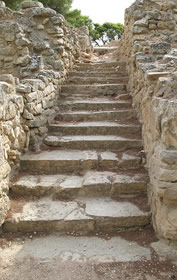
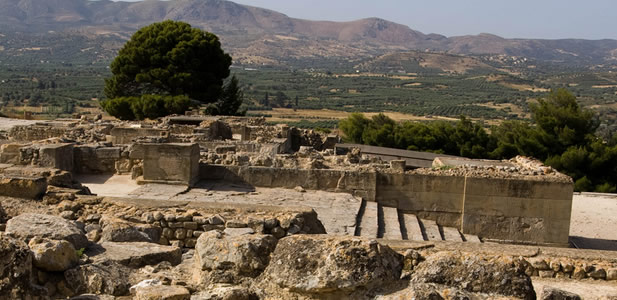
large storage jars were used for storing wine and olive oil.
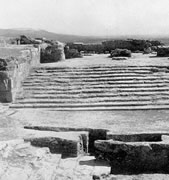
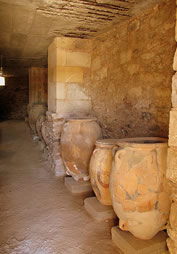
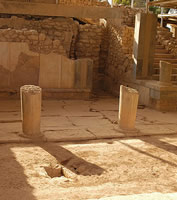
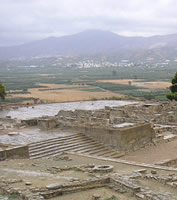
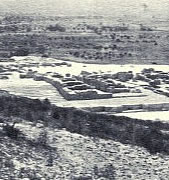
Federico Halbherr (Rovereto, then in the Austro-Hungarian Empire, 15 February 1857 – Rome, 17 July 1930) was an Italian archaeologist and epigrapher, known for his excavations of Phaistos
